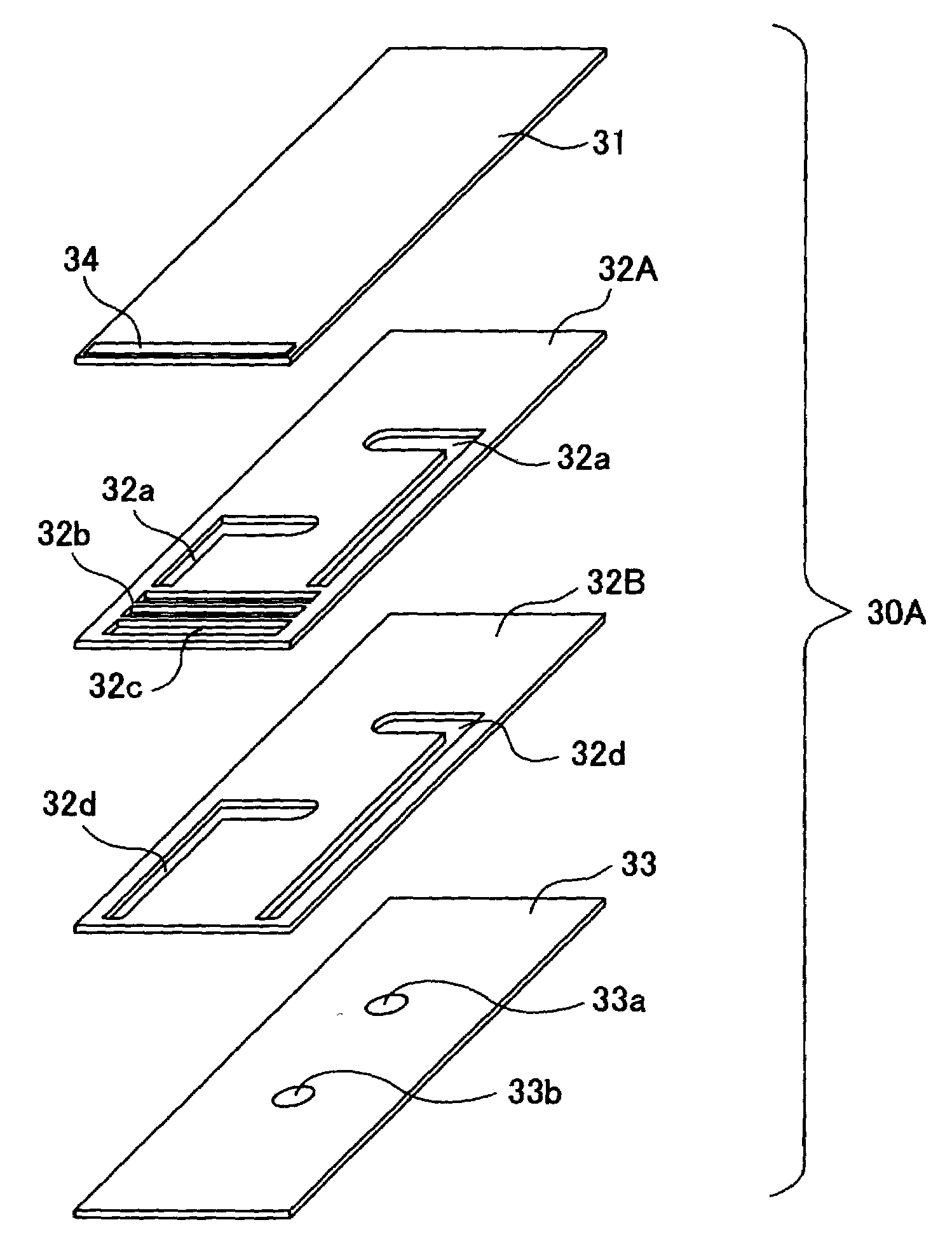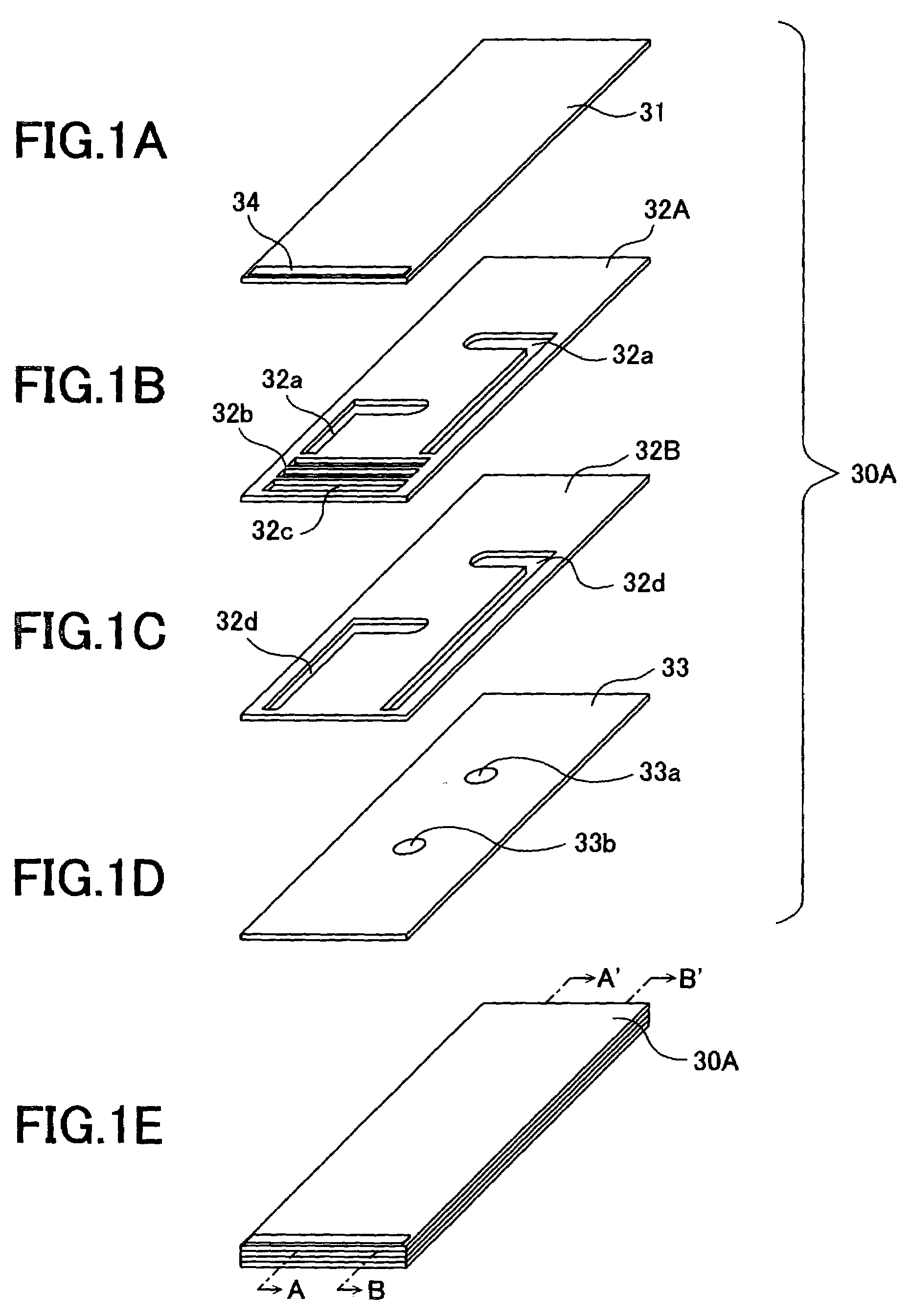Cooling device, semiconductor laser light source device, semiconductor laser source unit, method of manufacturing semiconductor laser light source unit and solid state laser device
a cooling device and laser light source technology, applied in semiconductor laser arrangements, semiconductor lasers, lasers, etc., can solve the problems of reducing laser pumping efficiency, expensive manufacturing costs, and b>10/b> also having a problem in manufacturing yield, so as to reduce processing costs and achieve efficient cooling of semiconductor laser arrays.
- Summary
- Abstract
- Description
- Claims
- Application Information
AI Technical Summary
Benefits of technology
Problems solved by technology
Method used
Image
Examples
embodiment 1
[0076]FIGS. 1A to 1D are exploded views each showing the construction of a cooling device 30A according to embodiment 1 of the present invention, and FIG. 1E is a perspective view showing a laminate constructed by members in FIGS. 1A to 1D. In FIGS. 1A to 1E, 31 refers to a plate-like member made of metal to which a semiconductor laser array 34, which is a cooled body, is connected. 32A and 32B refer to plate-like members in each of which a cooling channel functioning as a path for cooling fluid is formed. 33 refers to a plate-like member in which opening portions 33a and 33b are formed as a cooling fluid outlet and a cooling fluid inlet.
[0077]The thickness of the plate-like members 31 to 33 is determined based on the thickness of a laminate, the number of laminated layers, a pattern of a channel for constructing a cooling fluid flowing path, and so on. Typically, plate-like members in the order of 100 to 500 μm thick are selected, respectively.
[0078]Channels 32a and 32d, which func...
embodiment 2
[0095]In embodiment 1, a channel functioning as a cooling fluid flowing path is not formed in the plate-like member 32B at a position near a bottom surface of a position to which the semiconductor laser array 34 is connected. However, as shown in FIG. 5, a cooling channel 32e in slit shape, which is perpendicular to the flow of the cooling fluid in the cooling channel 32c of the plate-like member 32A may be formed in the plate-like member 32C at predetermined intervals.
[0096]FIG. 6A is a sectional view of a cooling fluid flowing path at a position where the cooling channel 32e in slit shape is formed in the cooling device 30C formed by using the plate-like member 32C, that is, a sectional view taken in the direction of the arrows substantially along the line E–E′ when plate-like members in FIG. 5 are laminated. FIG. 6B is a sectional view of a cooling fluid flowing path at a position where a divider 32f exists between adjacent, slit-shape cooling channels 32e, that is, a sectional v...
embodiment 3
[0101]FIGS. 9A to 9D is an exploded view showing the construction of a semiconductor laser light source device including a cooling device 30E according to embodiment 3 of the present invention. In FIG. 9, the same reference numerals as those in FIG. 1 are given to the same or like members as the cooling device according to embodiment 1, and the detail description will be omitted here.
[0102]In embodiment 3, the same members as those shown in embodiment 1 are used as the plate-like member 31, to which the semiconductor laser array 34 is connected, and the plate-like member 33, in which openings for the cooling fluid outlet and inlet are formed.
[0103]In FIG. 9B, a channel 32g, which functions as a path for introducing or draining cooling fluid, is formed near surfaces of both sides of the plate-like member 32D. The plate-like member 32D includes a cooling channel 32h, which is formed continuously with the channel 32g in the longitudinal direction of the semiconductor laser array 34 nea...
PUM
 Login to View More
Login to View More Abstract
Description
Claims
Application Information
 Login to View More
Login to View More - R&D
- Intellectual Property
- Life Sciences
- Materials
- Tech Scout
- Unparalleled Data Quality
- Higher Quality Content
- 60% Fewer Hallucinations
Browse by: Latest US Patents, China's latest patents, Technical Efficacy Thesaurus, Application Domain, Technology Topic, Popular Technical Reports.
© 2025 PatSnap. All rights reserved.Legal|Privacy policy|Modern Slavery Act Transparency Statement|Sitemap|About US| Contact US: help@patsnap.com



